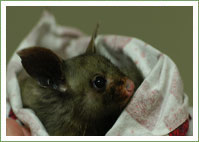Yellow-bellied Glider
Wednesday, November 9, 2011
This young female yellow-bellied joey was found on the Central Coast near Erina in October last year. She was found on the ground, alone with no mother able to be found. She weighed only 107 grams.
Luckily for her the weather was quite warm and she was not too cold when she was found. She was able to be immediately rehydrated and detailed advice was sort on her care as these gliders are not commonly in care in this area. It is estimated she was then a little over 3 months old.
She fed well from the start but once weaned was not too interested in either insects or the flowering gums and banksia carefully gathered for her aviary which form part of their natural food source.
As yellow-bellied gliders are listed as vulnerable the local NPWS were informed and she was microchipped prior to her release, so that if she ever comes into care again she can be identified. It was not an option to release her where she was found due to building work in the vicinity. Because of the vulnerable status of these gliders special permission was granted for her release into a national park and near a confirmed colony.
NPWS Biodiversity Officer, Doug Beckers and Alan Henderson assessed her suitability for release and conducted risk analysis of each area specifically for the welfare of the young glider.
We know little about these gliders and the more we can find out the better the chances of managing for their longer term conservation, and with this in mind some monitoring by NPWS via an infrared camera has been planned.
She now weighed 460 grams and had been in care for 6 months, with WIRES volunteers Gordana, Liz and Julie all contributing to her successful rehabiliation and care. All those involved were there to witness her release last week as her modified nest box was raised high up the tree. Now everyone hopes she will integrate quickly with the nearby colony.
Yellow-bellied gliders are large tree dwelling, nocturnal marsupials and can glide up to 140m between trees. They usually leave their roosting hollow after sunset to forage.
They live in family groups with a distinctive call and can be very vocal at night.
Thanks to WIRES Central Coast and Doug Beckers - NPWS for images and information

Recent Posts
WIRES launches its first wildlife rehabilitation centre - Mullyang
WIRES Emergency Response in the wake of ex-tropical cyclone Alfred
International Women’s Day Volunteer Spotlight: Shelley
Tropical Cyclone Alfred – Emergency Wildlife Advice
Interview with WIRES Training and Development
Celebrating Women in Science: The Journey of Holly, Wildlife Conservationist and WIRES Team Member
